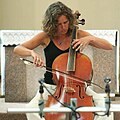Cello
Cello
The Cello or Violoncello is a string instrument that belongs to the violin family, which also includes the violin and viola. It is played by drawing a bow across its four strings, which are tuned in perfect fifths. The cello is known for its rich, warm tone and its ability to play a wide range of musical roles, from melody to harmony to rhythm.
History[edit]
The cello was developed in the 16th century, as a direct descendant of the bass violin. The first cellos were larger than the modern cello and had a less standardized shape. Over time, the design of the cello evolved to its current form, which is smaller and more standardized.
Construction[edit]
The cello is typically made of wood, with a hollow body that serves as a resonating chamber. The top and back of the cello are traditionally made of different types of wood: the top is usually made of spruce, while the back is typically made of maple. The cello's neck and scroll are usually made of maple as well.
Playing technique[edit]
Playing the cello involves a combination of different techniques, including bowing, plucking, and fingering. The player holds the cello between their knees and draws the bow across the strings to produce sound. The left hand is used to change the pitch of the notes by pressing down on the strings.
Repertoire and use in music[edit]
The cello has a vast repertoire, which spans from the Baroque era to the present day. It is used in a variety of musical genres, including classical music, jazz, folk music, and rock music. In addition to its use as a solo instrument, the cello is also a key component of orchestras, string quartets, and other types of chamber music ensembles.
See also[edit]
-
Cello front side
-
Range cello
-
Cello study
-
Violoncello open strings
-
Cello and a bow
-
Cello strung gut
-
Josephine van Lier plays violoncello piccolo
-
Alisa Weilerstein and Sujari Britt - Boccherini's Sonata for Two Cellos in C Major, 1st movement Allegro moderato
-
FHM Orchestra
-
Apocalyptica - Ilosaarirock 2009
-
Cello Parts
Ad. Transform your life with W8MD's Budget GLP-1 injections from $75


W8MD offers a medical weight loss program to lose weight in Philadelphia. Our physician-supervised medical weight loss provides:
- Weight loss injections in NYC (generic and brand names):
- Zepbound / Mounjaro, Wegovy / Ozempic, Saxenda
- Most insurances accepted or discounted self-pay rates. We will obtain insurance prior authorizations if needed.
- Generic GLP1 weight loss injections from $75 for the starting dose.
- Also offer prescription weight loss medications including Phentermine, Qsymia, Diethylpropion, Contrave etc.
NYC weight loss doctor appointmentsNYC weight loss doctor appointments
Start your NYC weight loss journey today at our NYC medical weight loss and Philadelphia medical weight loss clinics.
- Call 718-946-5500 to lose weight in NYC or for medical weight loss in Philadelphia 215-676-2334.
- Tags:NYC medical weight loss, Philadelphia lose weight Zepbound NYC, Budget GLP1 weight loss injections, Wegovy Philadelphia, Wegovy NYC, Philadelphia medical weight loss, Brookly weight loss and Wegovy NYC
|
WikiMD's Wellness Encyclopedia |
| Let Food Be Thy Medicine Medicine Thy Food - Hippocrates |
Medical Disclaimer: WikiMD is not a substitute for professional medical advice. The information on WikiMD is provided as an information resource only, may be incorrect, outdated or misleading, and is not to be used or relied on for any diagnostic or treatment purposes. Please consult your health care provider before making any healthcare decisions or for guidance about a specific medical condition. WikiMD expressly disclaims responsibility, and shall have no liability, for any damages, loss, injury, or liability whatsoever suffered as a result of your reliance on the information contained in this site. By visiting this site you agree to the foregoing terms and conditions, which may from time to time be changed or supplemented by WikiMD. If you do not agree to the foregoing terms and conditions, you should not enter or use this site. See full disclaimer.
Credits:Most images are courtesy of Wikimedia commons, and templates, categories Wikipedia, licensed under CC BY SA or similar.
Translate this page: - East Asian
中文,
日本,
한국어,
South Asian
हिन्दी,
தமிழ்,
తెలుగు,
Urdu,
ಕನ್ನಡ,
Southeast Asian
Indonesian,
Vietnamese,
Thai,
မြန်မာဘာသာ,
বাংলা
European
español,
Deutsch,
français,
Greek,
português do Brasil,
polski,
română,
русский,
Nederlands,
norsk,
svenska,
suomi,
Italian
Middle Eastern & African
عربى,
Turkish,
Persian,
Hebrew,
Afrikaans,
isiZulu,
Kiswahili,
Other
Bulgarian,
Hungarian,
Czech,
Swedish,
മലയാളം,
मराठी,
ਪੰਜਾਬੀ,
ગુજરાતી,
Portuguese,
Ukrainian










